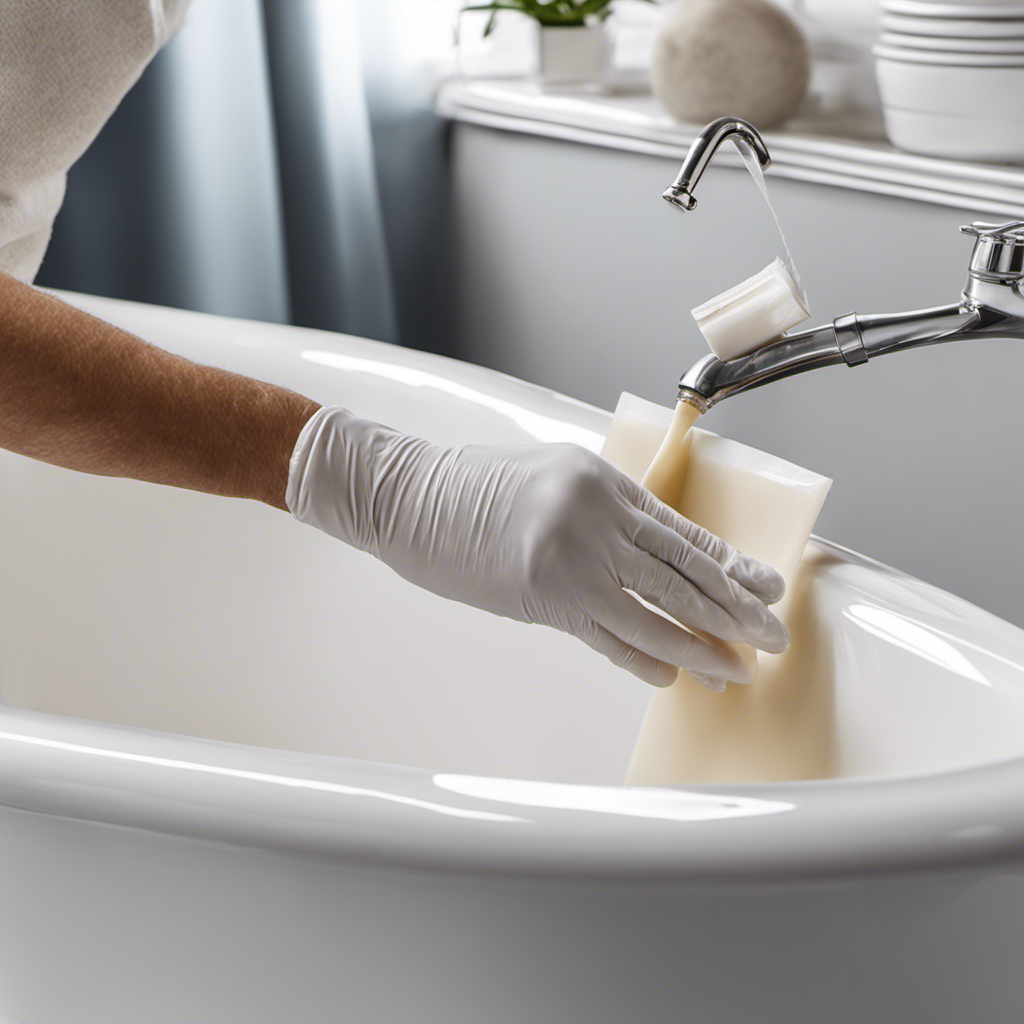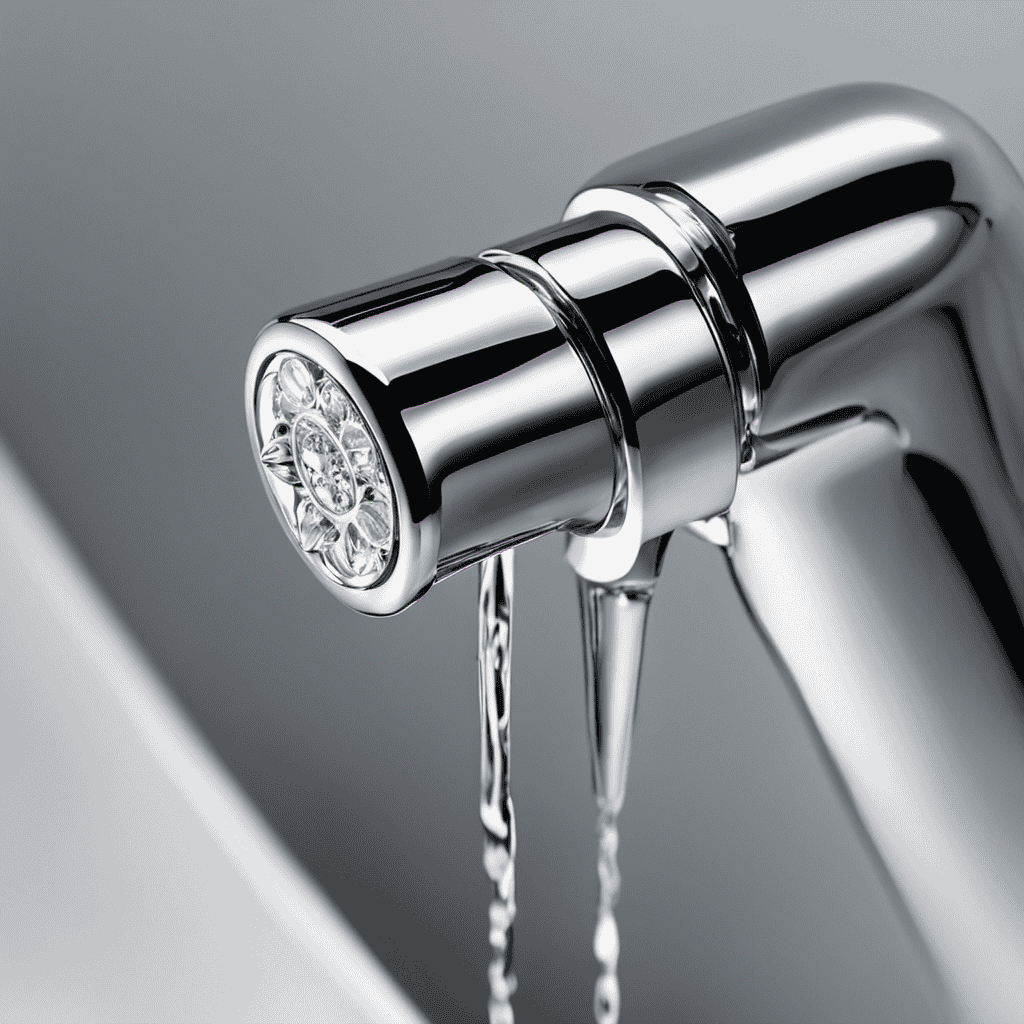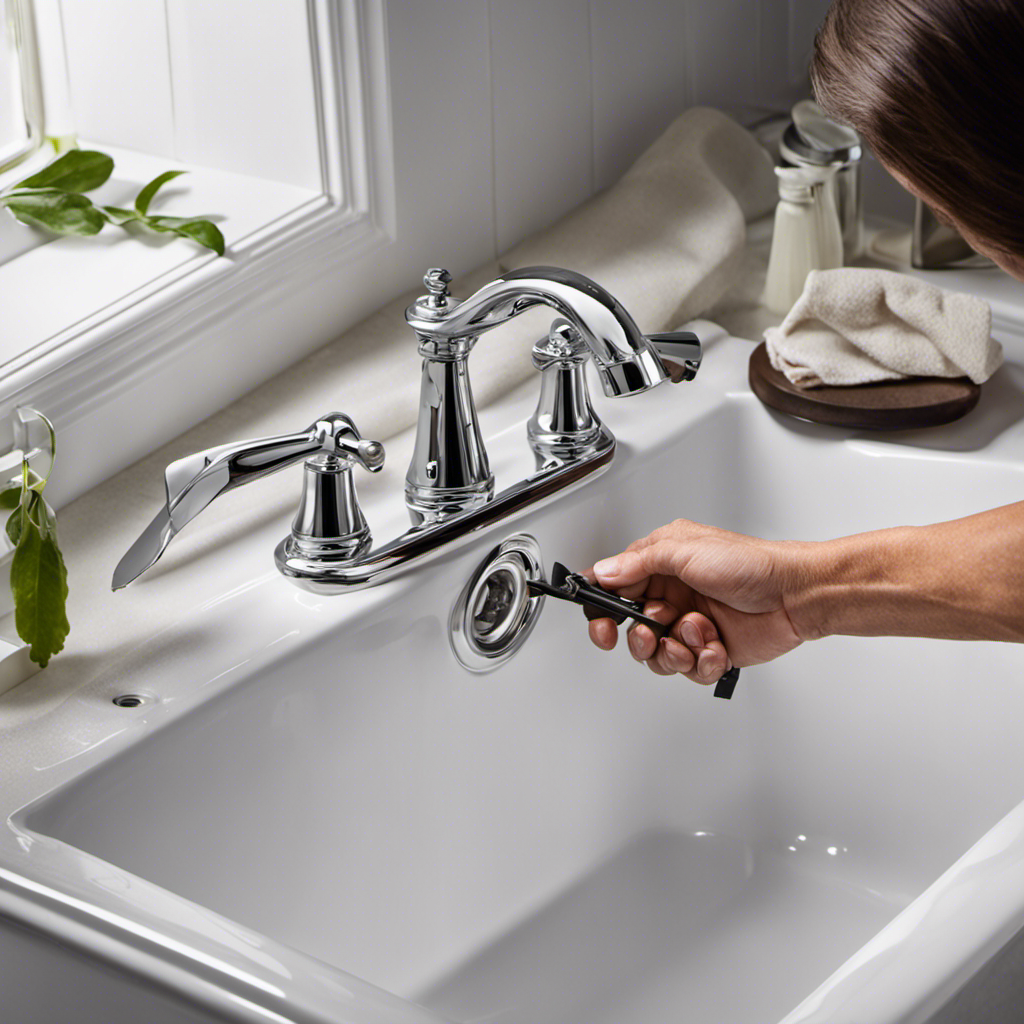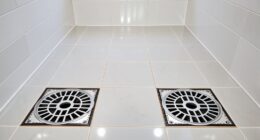I’ve tried everything to get those stubborn stains out of my bathtub, but nothing seems to work.
If you’re like me and tired of dealing with unsightly marks, you’ve come to the right place.
In this article, I’ll share with you the best techniques and solutions to effectively remove all types of bathtub stains.
Whether you’re dealing with rust, soap scum, or hard water marks, I’ve got you covered.
Get ready to say goodbye to those pesky stains and hello to a sparkling clean bathtub.
Key Takeaways
- Rust stains in a bathtub can be removed using a vinegar and baking soda solution.
- Soap scum can be effectively removed with warm water and dish soap.
- Hard water stains can be removed with lemon juice or commercial lime scale removers.
- It is important to identify the type of stain in order to choose the appropriate cleaning method.
Types of Bathtub Stains
To determine the best cleaning method, you’ll need to identify the specific type of stain in your bathtub.
Two common types of bathtub stains are rust stains and soap scum.
Rust stains occur when the metal in your bathtub starts to corrode, leaving behind a reddish-brown residue.
Soap scum, on the other hand, is a buildup of soap residue that can leave a white, hazy film on the surface of your tub.
To remove rust stains, you can use a mixture of vinegar and baking soda.
For soap scum, a mixture of warm water and dish soap can do the trick.
Understanding the type of stain in your bathtub is crucial for effective stain removal.
Now, let’s move on to the common causes of bathtub stains.
Common Causes of Bathtub Stains
When cleaning your bathtub, it’s important to understand what causes those pesky stains.
One common cause of stains is rust. Rust stains occur when metal objects are in contact with water or moisture for extended periods of time. The iron in the metal reacts with the oxygen in the water, resulting in rust formation.
Another common cause of stains is hard water. Hard water contains minerals like calcium and magnesium, which can leave behind deposits on your bathtub’s surface. These deposits can be tough to remove and can cause unsightly stains.
To remove rust stains, you can use a mixture of vinegar and baking soda. For hard water stains, lemon juice or a commercial lime scale remover can be effective.
Preparing the Bathtub for Stain Removal
Before starting the stain removal process, it’s important to thoroughly clean the bathtub. Proper bathtub maintenance ensures effective stain removal and prevents further damage.
To prepare the bathtub for stain removal, gather the necessary cleaning supplies. You will need a non-abrasive cleaner, a scrub brush or sponge, rubber gloves, and a bucket of warm water.
Begin by putting on the rubber gloves to protect your hands. Then, apply the non-abrasive cleaner to the stained areas and let it sit for a few minutes to loosen the dirt and grime.
Next, use the scrub brush or sponge to scrub the stains away. Be sure to scrub in circular motions and apply some pressure for stubborn stains.
Finally, rinse the bathtub with warm water from the bucket to remove any residue.
With a clean bathtub, you are now ready to tackle the stains.
Natural Remedies for Bathtub Stains
Using natural remedies is an effective way to remove stubborn stains from your bathtub. I have personally tried and tested these methods, and they have worked wonders for me. Here are three natural remedies that you can try:
-
Vinegar Solution: Mix equal parts of white vinegar and water in a spray bottle. Spray the solution onto the stained areas and let it sit for about 15 minutes. Scrub the stains with a sponge or brush, and then rinse thoroughly with water.
-
Lemon Juice Scrub: Cut a lemon in half and sprinkle some salt on one half. Use the lemon as a scrubber and rub it over the stains. The acidity of the lemon juice combined with the abrasiveness of the salt will help break down and lift the stains. Rinse off the lemon juice and salt residue with water.
-
Baking Soda Paste: Make a paste by mixing baking soda with water. Apply the paste to the stained areas and let it sit for about 30 minutes. Scrub the stains with a sponge or brush, and then rinse thoroughly with water.
These natural remedies are effective in removing most bathtub stains, but for more stubborn stains, chemical solutions may be required.
Now, let’s move on to the next section about chemical solutions for stubborn stains.
Chemical Solutions for Stubborn Stains
To effectively tackle those tough stains in your bathtub, try using a chemical solution specifically designed to break down and remove stubborn residue.
These solutions are specially formulated to target common stains like hard water stains and rust stains. Hard water stains are caused by mineral deposits that build up over time, leaving behind unsightly marks on your bathtub surface. Rust stains, on the other hand, occur when metal particles come into contact with water and oxidize, resulting in reddish-brown stains.
Chemical solutions contain powerful ingredients that penetrate deep into the stains, breaking them down and making them easier to remove. Simply apply the solution to the affected areas, let it sit for a few minutes, and then scrub away the stains using a sponge or brush.
With the right chemical solution, you can say goodbye to those stubborn stains and restore the beauty of your bathtub.
Tools and Techniques for Stain Removal
There are various tools and techniques available for effectively removing stubborn stains from your bathtub. Here are three options that can help you tackle those tough stains:
-
Baking Soda and Vinegar: Create a paste by mixing baking soda with vinegar. Apply it to the stained areas and let it sit for a few minutes. Scrub gently with a sponge or brush, then rinse with water. This natural remedy is great for removing soap scum and hard water stains.
-
Lemon Juice and Salt: Make a mixture of lemon juice and salt to form a paste. Apply it to the stains and let it sit for a while. Scrub the area gently with a sponge or brush, then rinse thoroughly. This combination is effective in removing rust stains.
-
Hydrogen Peroxide: Apply hydrogen peroxide directly to the stains and let it sit for a few minutes. Scrub the area gently with a sponge or brush, then rinse well. Hydrogen peroxide is excellent for removing tough stains like blood or dye.
By using these tools and techniques, you can effectively get rid of stubborn stains and restore the cleanliness of your bathtub.
However, to prevent future stains, it is important to establish a routine cleaning schedule and take proper care of your bathtub.
Preventing Future Bathtub Stains
In order to prevent future bathtub stains, it’s crucial to establish routine cleaning habits. This includes regular scrubbing and wiping down the bathtub surfaces with a mild cleaner to remove any dirt or residue.
Additionally, using protective products such as bath mats or non-slip coatings can help prevent stains caused by slips and falls.
Lastly, proper ventilation methods, such as using an exhaust fan or opening windows, can help reduce moisture levels in the bathroom. This prevents the growth of mold and mildew that can lead to staining.
Routine Cleaning Habits
Make sure you’re consistently cleaning your bathtub to prevent stains from building up. Establishing a cleaning schedule is crucial to maintaining a spotless tub. Here are three key steps to follow:
-
Choose appropriate cleaning products: Selecting the right cleaning products is vital for effectively removing stains. Look for cleaners specifically designed for bathtubs, such as those containing bleach or hydrogen peroxide.
-
Scrub regularly: Regular scrubbing is essential to prevent stains from adhering to the surface. Use a non-abrasive sponge or brush to gently scrub the tub, paying extra attention to areas prone to stains, like the corners and drain.
-
Rinse thoroughly: After scrubbing, rinse the bathtub thoroughly to remove any remaining cleaning solution. This step helps prevent residue buildup and ensures a clean finish.
Use Protective Products
To protect your tub from unwanted stains, consider using a non-slip mat or a protective cover when bathing. These products create a barrier between the surface of your bathtub and potential sources of stains, such as soap scum or hard water deposits.
Additionally, they provide traction, reducing the risk of slipping and falling. When choosing a non-slip mat or protective cover, look for options that are easy to clean and resistant to staining themselves.
Regularly remove and clean these products to prevent the buildup of dirt and grime. By incorporating these protective measures into your bathing routine, you can minimize the need for bathtub stain removal and keep your tub looking clean and pristine.
Proper Ventilation Methods
By ensuring proper ventilation in your bathroom, you can prevent the buildup of moisture and reduce the risk of mold and mildew. Here are some ventilation tips to help you maintain a fresh and odor-free bathroom:
-
Install a bathroom exhaust fan: A properly functioning exhaust fan can effectively remove moisture from the air, preventing condensation on surfaces and reducing the chances of mold growth.
-
Keep bathroom doors and windows open: Opening doors and windows can improve air circulation and allow fresh air to enter the bathroom, helping to eliminate odors and promote drying.
-
Use a dehumidifier: If your bathroom experiences high humidity levels, a dehumidifier can help remove excess moisture from the air, preventing mold and mildew growth.
Conclusion
In conclusion, removing stains from a bathtub can be a challenging task, but it is definitely achievable with the right tools and techniques.
By identifying the type and cause of the stain, you can determine the most effective method for removal. Whether you opt for natural remedies or chemical solutions, always remember to take necessary precautions and follow the instructions carefully.
By staying proactive and regularly cleaning your bathtub, you can prevent future stains from forming. So, say goodbye to those stubborn stains and hello to a sparkling clean bathtub!










